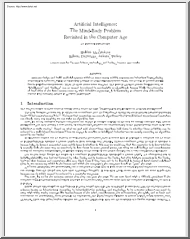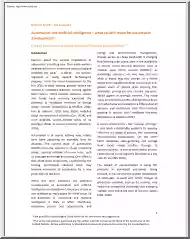A doksi online olvasásához kérlek jelentkezz be!

A doksi online olvasásához kérlek jelentkezz be!
Nincs még értékelés. Legyél Te az első!
Mit olvastak a többiek, ha ezzel végeztek?
Tartalmi kivonat
Source: http://www.doksinet ★ wingsuit flying Wingsuit By Phil Maranda Photos: James Boole, Scott burns Flying Lara Croft and her sidekick made it look easy in the movie Tomb Raider: The Cradle of Life, as they leapt from an unfinished skyscraper, then sprouted wings and glided through the air to land ever so gently on the deck of a moving ship. But make no mistake, UMM’ers, wingsuit flying is one, if not the most, technically extreme offshoots of skydiving around. And although it’s the closest us earth-bound bipedals will ever get to soaring like a bird, there’s much more to this sport than just jumping off a building or out of a perfectly good airplane. Source: http://www.doksinet ingsuits have been around for some time the rumour is, from back in the 1930’salthough successful wingsuit flying has only been with us for the past few decades, ever since the technology reached a non-suicidal level. Up until then, most people who were brave enough to strap on the
primitive wings, which were in some cases made of funky materials such as steel or whalebone, didn’t live to tell the tale. Eventually, the sport did glean a certain amount of safety out of an innovative new suit design. Fashioned by a French skydiver named Patrick de Gayardon, the new suit was lauded as the optimum in performance and safety. The curse of the birdmen was not stymied with Gayardon, however; he would die in Hawaii eight years later due to a rigging accident. But despite the continuing peril involved with wingsuit flying, there was an ever-increasing number of adventurers lining up to give it the old college try. “It’s a bit like racing down a mountain with an open anorak on a bike or skis,” said Ueli Gegenschatz, of the thrill of wingsuit flying. Gegenschatz is a Swiss birdman well known for his wingsuit-flying stunts. “Parachuters have a similar feeling, except that you can steer which direction you fly with the wings.” In the later part of our last
millennium, enthusiasts of the sport began collaborating on wingsuit designs, striving to make safer equipment. Two such men from Europe, Robert Pecnik and Jari Kuosma, formed a company, BirdMan Inc., with the idea of making wingsuit flying more functional and more accessible for skydivers; in fact, their design was the first wingsuit available to the general public. They then went on to introduce an instructor program, created by Kuosma, with the intentions of providing beginners with a safe way to experience the sport. Their efforts paved the way for future instructor programs and companies that would elevate wingsuit flying into the forefront of modern-day skydiving. In more recent years, with highly efficient suits and much safer equipment, enthusiasts began to push the envelope of flying, even adding small jet engines into the mix. On October 25th, 2005, a team strapped a couple of jets to the feet of Visa Parviainen, and he rocketed across the sky for a full 30 seconds, without
losing a lick of altitude. The era of level-human flight began and a number of similar experiments have since taken place. How wingsuit flying works: similar in design to a ram-air parachute, a wingsuit is rigged with cross-ventilated cells with inlets in the front portion of the wings, which allow air into the wings, subsequently inflating them. This system forms a rigid, aerodynamic airfoil. The wings’ surface area causes vertical drag, and this added to the shape of the wings and the birdman’s body positioning, “It’s a bit like racing down a mountain with an open anorak on a bike or skis,” Gegenschatz winter 2008 | 125 Source: http://www.doksinet ★ wingsuit flying Birdmen descend towards the ground at a much slower rate than that of a skydiver, reaching drop rates of around 90-100 km/h rather than the 180-225 km/h reached via their wingless brothers. allows for high-speed flights across the sky. The high speeds produce lift and reduce fall rates, which translates
into a longer glide time. Birdmen wear both a parachute and a wingsuit in their skydiving adventures and must learn the proper mechanics for bailing out of an aircraft that is moving at high speeds. They must have a firm grasp on exit procedures, such as where they’ll be in relation to the aircraft immediately upon exiting the door and at what moment and in what way they’ll spread their arms and legs so they won’t hit the aircraft. Launching from a cliff, as in BASE jumping, or in most other instances where the velocity of a moving aircraft is absent, requires the use of gravity as an accelerating force that propels the jumpers towards the earth until just enough airspeed is present to allow the deployment of the wingsuit-producing lift. Once the glide is coming to an end, due to the proximity of the ground, birdmen deploy their parachutes in the same fashion as any other skydiver. Birdmen descend towards the ground at a much slower rate than that of a skydiver, reaching drop
rates of around 90-100 km/h rather than the 180-225 km/h reached via their wingless brothers. They use a combination of body dynamics and wingsuit design to manipulate their fall rate. By adjusting the shape of their torsos and by changing the angles of the wingsuit itself, birdmen can adjust their speed and enhance the distance of their horizontal glide. What does it take to become a high-flyer? I’m glad you asked! According to the United States Parachuting Association, anyone with the passion to become a birdman should log at least 200 skydiving-type jumps and be accompanied by an instructor for their initial wingsuit experience or have at least 500 jumps to go it alone. With the advent of the safer, highly efficient wingsuits, the tiny jet engines, and the sheer determination of the birdmen who are now gliding across the skies in locations around the globe, the sky is no longer the limit of what is possible. The number of wingsuit flyers is constantly rising, and new glide-time
records are being set and then broken and then broken again. You no longer have to have the chandeliers of Evel Knievel, and life expectancy is way up, making the sport within the grasp of anyone who enjoys jumping out of that perfectly good airplane. For more information on Wingsuit Flying check out: www.phoenix-flycom or wwwsky2productionscom Getting into it! Before you can fly with a wingsuit, you’ve got to learn how to skydive. The good news is that wherever you find a good flight schooland there are dozens of skydiving schools all over North America and Europethat offers skydiving courses, there’s also the possibility that you may not need to look any further for the wingsuit lessons once you’re ready, of course. Now for the expense news, which can be a pretty big nut, depending on how you want to go about participating in the sport. First, you’re going to need the initial training, and that can cost you upwards of 800 clams, no matter where you are. These courses do
include everything you need, including gear rentals, to get going. Then, once you’ve passed your beginners’ course, you’ll need to log in roughly 200 jumps at about $25.00 a piece, assuming you splurge on your own gear at $500000+ for new stuff As an encore, you’ll then probably want to purchase a brand spanking new wingsuit to begin your instructions, and that will run another G-note or more. The question is: what kind of a price tag can you place on airborne freedom? 126 | winter 2008
primitive wings, which were in some cases made of funky materials such as steel or whalebone, didn’t live to tell the tale. Eventually, the sport did glean a certain amount of safety out of an innovative new suit design. Fashioned by a French skydiver named Patrick de Gayardon, the new suit was lauded as the optimum in performance and safety. The curse of the birdmen was not stymied with Gayardon, however; he would die in Hawaii eight years later due to a rigging accident. But despite the continuing peril involved with wingsuit flying, there was an ever-increasing number of adventurers lining up to give it the old college try. “It’s a bit like racing down a mountain with an open anorak on a bike or skis,” said Ueli Gegenschatz, of the thrill of wingsuit flying. Gegenschatz is a Swiss birdman well known for his wingsuit-flying stunts. “Parachuters have a similar feeling, except that you can steer which direction you fly with the wings.” In the later part of our last
millennium, enthusiasts of the sport began collaborating on wingsuit designs, striving to make safer equipment. Two such men from Europe, Robert Pecnik and Jari Kuosma, formed a company, BirdMan Inc., with the idea of making wingsuit flying more functional and more accessible for skydivers; in fact, their design was the first wingsuit available to the general public. They then went on to introduce an instructor program, created by Kuosma, with the intentions of providing beginners with a safe way to experience the sport. Their efforts paved the way for future instructor programs and companies that would elevate wingsuit flying into the forefront of modern-day skydiving. In more recent years, with highly efficient suits and much safer equipment, enthusiasts began to push the envelope of flying, even adding small jet engines into the mix. On October 25th, 2005, a team strapped a couple of jets to the feet of Visa Parviainen, and he rocketed across the sky for a full 30 seconds, without
losing a lick of altitude. The era of level-human flight began and a number of similar experiments have since taken place. How wingsuit flying works: similar in design to a ram-air parachute, a wingsuit is rigged with cross-ventilated cells with inlets in the front portion of the wings, which allow air into the wings, subsequently inflating them. This system forms a rigid, aerodynamic airfoil. The wings’ surface area causes vertical drag, and this added to the shape of the wings and the birdman’s body positioning, “It’s a bit like racing down a mountain with an open anorak on a bike or skis,” Gegenschatz winter 2008 | 125 Source: http://www.doksinet ★ wingsuit flying Birdmen descend towards the ground at a much slower rate than that of a skydiver, reaching drop rates of around 90-100 km/h rather than the 180-225 km/h reached via their wingless brothers. allows for high-speed flights across the sky. The high speeds produce lift and reduce fall rates, which translates
into a longer glide time. Birdmen wear both a parachute and a wingsuit in their skydiving adventures and must learn the proper mechanics for bailing out of an aircraft that is moving at high speeds. They must have a firm grasp on exit procedures, such as where they’ll be in relation to the aircraft immediately upon exiting the door and at what moment and in what way they’ll spread their arms and legs so they won’t hit the aircraft. Launching from a cliff, as in BASE jumping, or in most other instances where the velocity of a moving aircraft is absent, requires the use of gravity as an accelerating force that propels the jumpers towards the earth until just enough airspeed is present to allow the deployment of the wingsuit-producing lift. Once the glide is coming to an end, due to the proximity of the ground, birdmen deploy their parachutes in the same fashion as any other skydiver. Birdmen descend towards the ground at a much slower rate than that of a skydiver, reaching drop
rates of around 90-100 km/h rather than the 180-225 km/h reached via their wingless brothers. They use a combination of body dynamics and wingsuit design to manipulate their fall rate. By adjusting the shape of their torsos and by changing the angles of the wingsuit itself, birdmen can adjust their speed and enhance the distance of their horizontal glide. What does it take to become a high-flyer? I’m glad you asked! According to the United States Parachuting Association, anyone with the passion to become a birdman should log at least 200 skydiving-type jumps and be accompanied by an instructor for their initial wingsuit experience or have at least 500 jumps to go it alone. With the advent of the safer, highly efficient wingsuits, the tiny jet engines, and the sheer determination of the birdmen who are now gliding across the skies in locations around the globe, the sky is no longer the limit of what is possible. The number of wingsuit flyers is constantly rising, and new glide-time
records are being set and then broken and then broken again. You no longer have to have the chandeliers of Evel Knievel, and life expectancy is way up, making the sport within the grasp of anyone who enjoys jumping out of that perfectly good airplane. For more information on Wingsuit Flying check out: www.phoenix-flycom or wwwsky2productionscom Getting into it! Before you can fly with a wingsuit, you’ve got to learn how to skydive. The good news is that wherever you find a good flight schooland there are dozens of skydiving schools all over North America and Europethat offers skydiving courses, there’s also the possibility that you may not need to look any further for the wingsuit lessons once you’re ready, of course. Now for the expense news, which can be a pretty big nut, depending on how you want to go about participating in the sport. First, you’re going to need the initial training, and that can cost you upwards of 800 clams, no matter where you are. These courses do
include everything you need, including gear rentals, to get going. Then, once you’ve passed your beginners’ course, you’ll need to log in roughly 200 jumps at about $25.00 a piece, assuming you splurge on your own gear at $500000+ for new stuff As an encore, you’ll then probably want to purchase a brand spanking new wingsuit to begin your instructions, and that will run another G-note or more. The question is: what kind of a price tag can you place on airborne freedom? 126 | winter 2008




 Ahogy közeledik a történelem érettségi, sokan döbbennek rá, hogy nem készültek fel eléggé az esszéírás feladatra. Módszertani útmutatónkban kitérünk a történet térbeli és időbeli elhelyezésére, a források elemzésére és az eseményeket alakító tényezőkre is.
Ahogy közeledik a történelem érettségi, sokan döbbennek rá, hogy nem készültek fel eléggé az esszéírás feladatra. Módszertani útmutatónkban kitérünk a történet térbeli és időbeli elhelyezésére, a források elemzésére és az eseményeket alakító tényezőkre is.